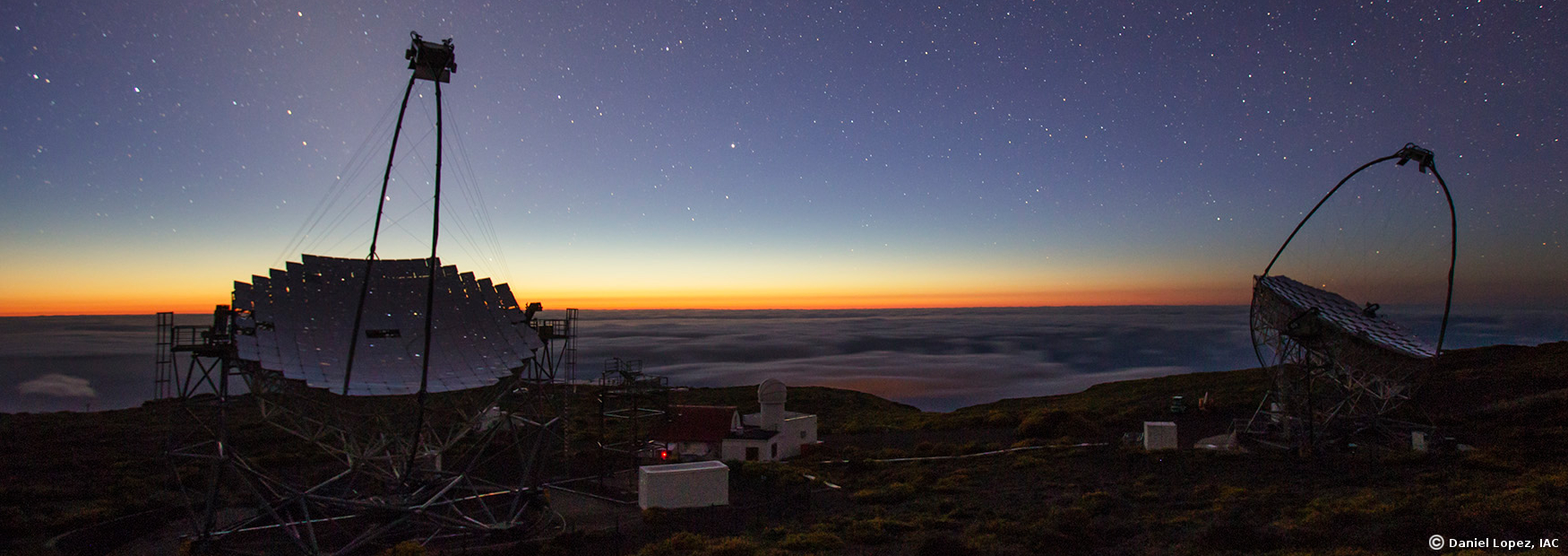MAGIC
Skip navigation and go to main content
- Home
- General Information
- Science with MAGIC
- MAGIC members
- Maintenance

|
Home
Welcome to MAGIC!
The pioneering instrument for covering the electromagnetic spectrum in the energy range above 30 GeV

The two MAGIC telescopes. Image credits: Daniel Lopez/IAC
MAGIC (Major Atmospheric Gamma Imaging Cherenkov) is a system of two 17 m diameter, F/1.03 Imaging Atmospheric Cherenkov Telescopes (IACT).
They are dedicated to the observation of gamma rays from galactic and extragalactic sources in the very high energy range (VHE, 30 GeV to 100 TeV).
The MAGIC telescopes are currently run by an international collaboration of about 165 astrophysicists from 24 institutions and consortia from 12 countries.
MAGIC in a Nutshell
The main goal of the MAGIC project was to build an instrument that could perform measurements in an energy range below 100 GeV, down to about 30 GeV, up to the high-energetic
"terra incognita" of the electromagnetic emission spectrum, traditionally considered as the classical domain of satellite-born instruments. MAGIC researchers were
anticipating finding new classes of gamma-ray sources such as, for example, pulsars and Gamma Ray Bursts (GRB). Because of the strong absorption of TeV
gamma rays by the extragalactic background light, MAGIC was aiming to measure sources at few tens of GeV, where the universe becomes progressively
more transparent. At lower energies, one can search for powerful sources residing at large redshifts. The telescopes measure Cherenkov light images of extended air showers from a target source direction. The software analysis allows, with very high efficiency, to select
neutral gamma-ray induced electromagnetic showers from the several orders of magnitudes more intense isotropic background due to the charged particle (mostly hadron) induced
showers. The MAGIC telescopes are located at a height of 2200 m a.s.l. on the Roque de los Muchachos European Northern Observatory on the Canary Island of La Palma
(28°N, 18°W).
The first ideas on the project date back to mid-1994. While several groups joined the MAGIC effort already in 1996, the formal collaboration for constructing the first MAGIC
telescope (MAGIC-I) has been formed in 1998. The first telescope was built between 2001 and 2003 and the scientific observations started in 2004. The commissioning of
second telescope (MAGIC-II) has been finished in autumn 2009. The two telescopes, separated by 85 meters, are usually operated in coincidence, in the so-called stereoscopic mode.
Only events which trigger both telescopes in a narrow time window of 180 nanoseconds are recorded and analyzed. Compared to the stand-alone MAGIC-I,
operated till mid-2009, the use of the two telescopes provided a significant increase of the sensitivity due to stronger background rejection. The energy and angular resolutions
have been improved, mainly due to the higher precision of the three-dimensional reconstruction of air shower impact point and its incoming direction.
Recent MAGIC Highlights
MAGIC Astronomers' Telegrams






